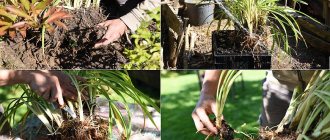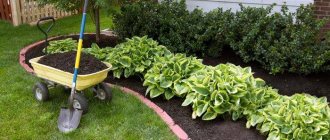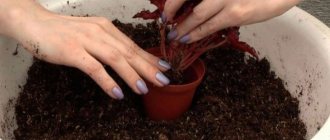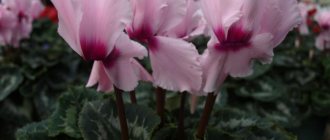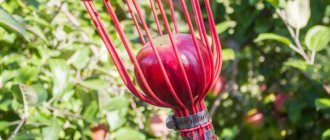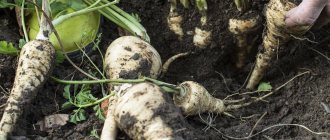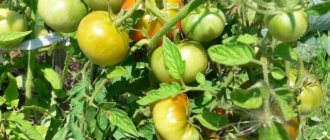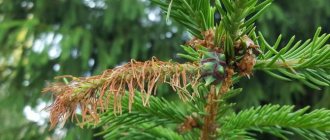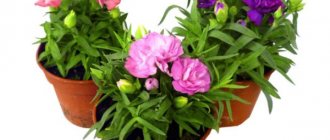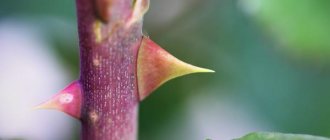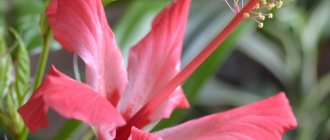Plant characteristics
A plant native to Japan, used in the landscape design of shady gardens, attracts attention with its various patterns on the leaves. Growing hosta does not require bright light, so the culture occupies shady areas that are unsuitable for other plants .
Gardeners are attracted by the variety of leaf shapes located on long stems and colors ranging from milky to purple.
There are up to 4 thousand hosta varieties with leaf lengths from 10 cm to 1 m.
Popular varieties in demand in Europe and Russia include:
- Alex Summers with a gold stripe along the edge and a bluish tint;
- August Moon with yellow leaves;
- First Frost is a chameleon variety that changes color from blue to green;
- Captains Adventure, characterized by an unusual “waffle” structure of oval sheet plates;
- Allegan Fog with twisted white-green leaves.
Hosta, belonging to the genus Agave, is a perennial herbaceous plant. The flowering period extends from June to September. When the bell-shaped flowers, painted in white, purple, and lilac tones, fade, boxes with seeds are formed.
Every year the crop increases its green mass and looks like an island with tropical vegetation.
The decorative value of hostas is reduced by sunburn, frost burns, pests and diseases, which are difficult to immediately identify due to the denseness of the bushes.
Description
Hybrid host "Halcyon" (Latin name Hosta hybrida Halcyon) belongs to the classic host species. Its medium-sized, heart-shaped leaves have a textured surface formed from longitudinal veins. The average width of an individual leaf is about 100 mm, and the length of the leaf plate is 160 mm. The plant reaches a height of up to half a meter, but at the moment of flowering the peduncle throws out buds 0.7 m above the ground.
When describing the hosta, it should be noted that the lavender-colored flowers, similar to elongated funnels, collected in spike-shaped inflorescences, look rather inconspicuous and are not the highlight of the plant. The true decoration of the Halcyon variety is the blue, waxy color of the dense leaves. The deep blue of the leaf mass persists throughout the season.
Diseases
High summer temperatures coupled with high humidity and excess nitrogen in the soil lead to fungal diseases. Along with rot and spots, the crop is affected by a specific virus that develops only on the host.
Viruses X, HVX
Hosta Virus X (HVX) was discovered by the American scientist Lockhart at the end of the 20th century. The disease is transmitted through sap that gets on gardening tools or hands while pruning leaves or dividing a bush. When you touch healthy plants with an undisinfected hoe or unwashed hands, the virus penetrates through cuts and wounds into the tissue of the crop, begins to feed and multiply.
Signs
Before the discovery of the virus, yellow spots, small inclusions, streaks, and rings were mistaken for the unusual coloring of the hosta. But later, it became clear that this is a disease leading to insufficient growth and leaf curling.
Distinctive features of Hosta Virus X (HVX):
- different tissue densities, uneven coloring in areas of one sheet;
- the effect of “spreading ink” on the veins of leaf blades - interveinal chlorosis;
- blurry spots, mosaic;
- slower bush development, dwarfism;
- change in flower color, lack of ovary.
The Siebold host virus and its hybrids are resistant to the virus, but this fact does not guarantee the elimination of the risk of disease.
Treatment methods
If a virus is detected, there is no point in preserving the plant, since the disease cannot be treated and spreads to all parts of the host, gradually leading to the death of the plant. It is advisable to burn the sick hosta and soak the equipment in formaldehyde or manganese solution.
Phyllosticosis
Both indoor and garden crops are susceptible to phyllosticosis or brown spot. The Phyllosticta fungus develops rapidly when there is excess humidity and air temperatures above 25°C.
See also
Growing, planting and caring for dahlias in open groundRead
How to determine
A characteristic sign of the introduction and spread of the fungus is the formation of brown spots with black dots. The affected areas of the hosta dry out and die. The advanced stage of Phyllosticosis leads to the death of the plant.
How to treat
Leaves and flower stalks with foci of fungal spores are burned, reducing the frequency and volume of irrigation of the hosta. If the plant is severely affected, remove the entire crop.
Since the disease is easily transmitted to neighboring plants, the diseased hosta is transplanted to a separate area. Brown spot is combated by spraying every 10 days before flowering. Fungicides Strobi, Vectra, and copper sulfate are suitable for treating hostas. Experienced gardeners use a solution of colloidal sulfur prepared from half a glass of dry matter and 10 liters of water.
Gray rot
Gray rot fungi are omnivores. They affect herbaceous plants, flower and fruit crops. The disease is not only common, but also dangerous. If measures are not taken in time, the plant will die. The botrytes mushroom forms mycelium on the crop with a large number of spores, which fall on neighboring plants with the wind.
Signs
Signs of gray mold are distinguished depending on the stage of development of the disease.
initial stage
Spores of the Botrytis fungus are manifested by the appearance of an ash coating, rotting, deformation and drying of the tops and edges of the leaf plate. In the early, treatable stages, part of the leaf dies.
Neglected case
In advanced cases, gray rot spreads over the entire area of the plate and stem, which subsequently dry out, lie on the ground and crumble. In this case, the plant is removed from the ground and destroyed.
Treatment options
Gray mold is easier to prevent than to treat. The first tillage is carried out in early spring when the soil is first loosened. Planting sites are sprayed with copper-based contact preparations from a spray bottle (Abiga-pik, Khom, Oksikh).
After the first leaves appear, spraying is carried out with systemic agents - Acrobat, Previkur, Profit Gold, Fundazol, Skor. After 2 weeks the event is repeated.
If preventive measures are not followed, and the first signs of the development of the Botrytis fungus are visible on the leaves, immediately begin treating the host with Fundazol, Topaz, Ridomil Gold.
At the end of the growing season, plant residues are collected and burned.
Root collar rot
The disease is caused by various types of fungi that rapidly develop in dense shady plantings with excess moisture and deepening of rhizomes.
How to diagnose
Root collar rot is recognized by changes in leaf color. The plates first turn yellow from the edges to the center, maintaining density, then become discolored and dry out. If you pull the stem, the leaf will fall off, exposing the root collar with a characteristic coating.
How can you cure
To combat and prevent root rot, pour a solution consisting of 1 tbsp under the root. l. Previkura and a liter of water. Treatments of bushes with the following preparations are effective:
- biologically active Fitolavin, Trichovit, which help young plants to a greater extent;
- Trichodermin, acting on a wide range of fungal and bacterial diseases;
- Topaz - a systemic agent;
- medium toxicity Maxim;
- Mikosan, which forms the immune defense of the host.
Spraying with copper sulfate and Bordeaux mixture is effective..
But it’s better not to risk the health of the culture. When the first leaf turns yellow, the hosta is removed from the soil, the rhizome is washed, and inspected for rot. The affected areas are cut out with a sharp knife, the sections are treated with fungicides or crushed activated carbon. Leave the sick hosta for 1–2 hours to dry, then plant it in a separate container.
See also
How to get rid of midges in indoor flowers using chemical and folk remediesRead
Rust
Rust most often affects hosta varieties with a yellow border during dry periods with insufficient watering. The disease dries out the leaves, disrupting metabolism and the process of photosynthesis.
No measures taken will restore the decorative appearance of the plant. To prevent loss of moisture from the leaf blades, the crop is planted in the shade and the soil is not allowed to dry out.
Fighting methods
If hosta shrubs suffer from a viral disease, then their treatment is that the plant is completely removed from the ground and burned directly along with the adjacent soil mixture. Unfortunately, there is no way to save the plant, and it is pointless to treat it. Those garden tools that were used for digging are reliably treated with a disinfectant, for example, soaked in a solution of manganese or formaldehyde. Unlike viruses, phyllostictosis can be cured. You need to do the following: first reduce the amount of irrigation of the bush and completely eliminate the damaged parts - cut and burn them.
At the next stage, the remaining plant is treated with a suitable medicinal composition, for example, Strobi or Vectra, which is applied by spraying. Experienced gardeners often use colloidal sulfur, half a glass of which must be diluted in 10 liters of settled liquid. The buds must be additionally treated with copper sulfate diluted in water, or with a solution of colloidal sulfur. This treatment is repeated after another 10 days, and then as many times as required for complete healing.
It is necessary to mention that the disease easily and quickly “jumps” to neighboring plants, so it is recommended to transplant the diseased shrub to another area.
To treat the initial stage of gray rot, it is enough to simply spray the diseased leaves with a suitable medicine - Bordeaux mixture, Topaz or Champion. If it was not possible to quickly correct the situation with putrefactive diseases, then there is only one way to fight them - completely dig up the bush, burn it along with the ground and do not forget about processing the tools.
Treatment of root collar rot occurs as follows: if the disease has appeared recently, the bush will have to be completely dug up and freed from that part of the root system that is covered with rot using a treated knife. The cut areas are immediately coated with a fungicide or other disinfectant. The treated host must be transplanted to a new place so as not to provoke a recurrence of the disease.
If the initial moment of the disease is missed, then the bush will have to be dug up and burned, and the place where it grew must be treated with a disinfectant.
To treat rust, simply change the care of your hosta. To do this, the shrub is transplanted to a shady area, and the irrigation process is made more balanced and must be carried out using naturally warmed water . In addition, it is important for the shrub to provide regular spraying. Getting rid of “soft” rot is carried out only by destroying the bush. After work, it is necessary to thoroughly wash your hands and gloves, and also disinfect the tools used. It is unlikely that it will be possible to cure hosta from petiol. The plant must be removed from the soil and destroyed, not forgetting about the removal of contaminated soil.
It is important to add that some varieties of hosta are rare, expensive, and therefore valuable, so it may be a pity to just throw them away . You can try to transplant the infected shrub into a separate container, isolating it from the rest of the garden’s inhabitants, and then try to treat the hosta and look at its further “behavior.”
Pests
More often than diseases, the hosta is harmed by attacks from slugs, beetles, caterpillars, leaf nematodes and rodents.
Slugs and snails
Low-growing, thin-leaved hosta varieties are more susceptible to attack by slugs and snails. Some leaves of the crop, located close to the soil, are just emerging from the ground when they are already eaten by pests. As a result, after the sprout blooms, holes are visible on the leaf plate. Sticky, silvery trails of mucus on the host signal a gastropod attack.
Pest control begins in early spring, sprinkling the ground with ash, tobacco, pouring vinegar, and placing beer traps. You can place damp cardboard sheets or newspapers under the bushes, and the next morning collect the mollusks that have accumulated under the objects. If folk remedies do not bring results, use the drugs Thunderstorm, Bros for slugs, Slug Eater. Granules are placed under each bush three times during the summer.
Beetles and caterpillars
Beetles, grasshoppers, and caterpillars can cause great damage to the hosta. Insects eat leaves from the edges and gnaw holes. They damage stems, damage buds and blooming flowers. If there are few insects, mechanical collection and sprinkling irrigation are effective. If there is a threat of plant destruction, the host is treated with Karbofos, Iskra, Intavir. Since the pupae overwinter in the ground, for prevention, they dig up the soil in the fall.
Foliar nematodes
Microscopic roundworms of the genus Aphelenchoides, up to 1 mm long, penetrate through lesions and ostia located on the underside of the leaf. Brown stripes remain in the path of parasitic activity. Later, the leaves stop developing and dry out.
Folk remedies are powerless in the fight against nematodes. The only effective way to disinfect the soil where insects hibernate is to pour boiling water over the soil to a depth of 20 cm and cover it with film to allow it to cool slowly .
From chemical preparations, gardeners distinguish contact and systemic poisons, which they spray on bushes:
- Dimethoate;
- Karbofos;
- Lindan;
- Phosphamide.
Since the listed products are toxic, follow the instructions for use.
Rodents
To protect the stems and roots of the crop, covered with mulch for the winter, from the teeth of rodents, the hosta is buried in the ground along with a fine-mesh metal mesh attached around the rhizome, and poisonous baits are scattered nearby.
Care
Planting hostas and caring for them in open ground does not take much time. After planting, the host takes root within 4-5 weeks; during this period, it needs nothing but water. Unless it's shading. In the first two years of life in a new place, the hosta is not fertilized; the nutrients provided during planting are sufficient for it.
The peduncle, if it appeared in the first year, must be broken off. In subsequent years, flowers can be left. In varieties of beautifully flowering hostas, the flowers are always left (except for the first year); in hostas purchased for decorative leaves, the flower stalks are broken off as soon as they appear. If you don’t break out the flowers in time, the bush will begin to fall apart in width and will resemble someone’s nest.
In the third year, the hosta can be fed with chemical mineral fertilizers 1-3 times per season. The first time is when young leaves appear. The last feeding can be done no later than the beginning of July.
The fertilizer composition should contain equal parts of nitrogen (N), phosphorus (P) and potassium (K) NPK (1:1:1). It is recommended to fertilize in July with fertilizer with a high phosphorus content NPK (1:2:1), so the plant will have time to rebuild and prepare for winter.
In cold areas, bushes are additionally covered with foliage for the winter. In spring, the leaves are very carefully moved apart so as not to damage the young shoots. Hosts are slow-witted and wake up quite late.
Treatment and prevention of the most common hosta disease
The most common culture disease, Hosta Virus X (HVX), cannot be treated. To avoid exposing healthy plants to infection, garden tools are treated with a disinfectant solution after use.
It is difficult to prevent the virus from entering the garden plot, but it is possible to reduce the risks.
It is recommended to choose planting material from trusted nurseries and compare the leaf pattern of the proposed plant with the image of the variety in the catalog. If there is a mosaic, streaks, spots on the leaf plate that are not declared for this variety, then the plant cannot be purchased.

